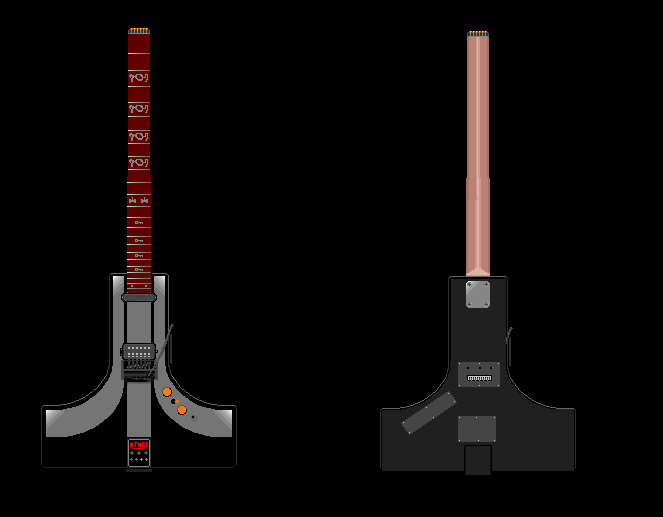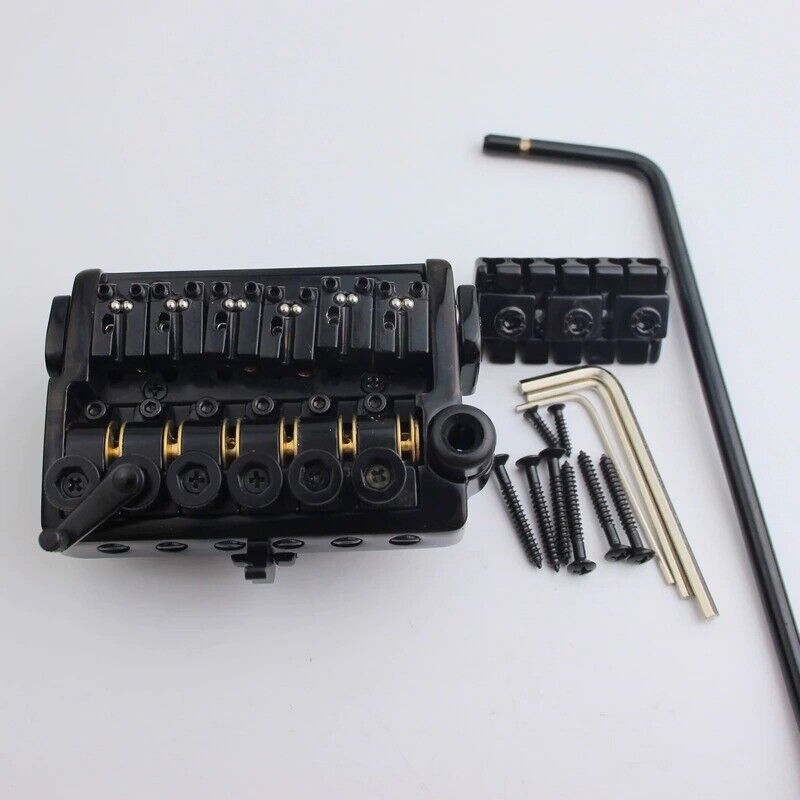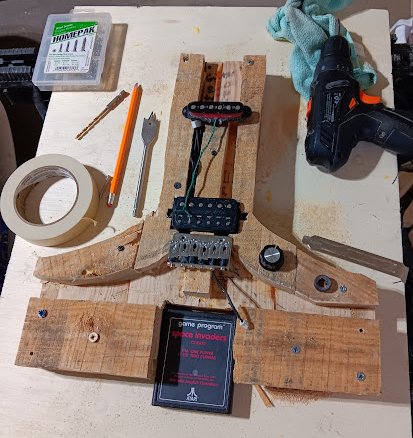

 (aka "The Ataricaster") Headless Polyphonic Synth/Guitar Hybrid |
 Okay, this is what I'd consider to be probably one of my most ambitious projects to date. And it's actually not THAT new of an idea. The idea for a Atari "Fuji" logo guitar has been a long-standing idea in my brain that's collected cobwebs for about, uh, 20-25 years. Okay, this is what I'd consider to be probably one of my most ambitious projects to date. And it's actually not THAT new of an idea. The idea for a Atari "Fuji" logo guitar has been a long-standing idea in my brain that's collected cobwebs for about, uh, 20-25 years.
I decided to re-write this whole section, the idea is still somewhat the same, but some things have changed since I'm trying not to stress myself out considering how ambitious this project is. The Graf-X II designed pixel-art mockup (left) is what I originally designed for this project when I de-mothballed it in 2023. The plan is to make a headless electric guitar, using a First Act combination Hexaphonic pickup/stacked Humbucker (8.4K), and possibly a Sustainer, to create a self-contained Synth/Guitar hybrid, shaped like the Atari logoThe History (2001-2024) The original idea for what was originally known as the Flying Fuji later the Guitari 2600 and lastly now I've been calling it the Ataricaster, came about in 2001. Back then, I was a rampant video game collector, and playing in a Nu-Metal band called "Lithium" at the time, and wanted a kinda' funny-cool way to combine the hobby and the band a little. So I designed a guitar that looked like the Atari logo, because I thought it'd look cool, however, my original idea was a bit different in execution. Basically, the guitar would have a headstock originally (shaped like the same logo), and have fretboard markers shaped like various Atari game characters (an idea I may still use, especially if I end up using a headless Yinfente neck that has inlays that pull right out like the Warlock ones did). I planned to just throw a Floppy Diskette drive in the back of the guitar that would drop out demo floppies - as well as would be a ruse to my rampant pedalboard wizardry at the time (making people think it was the guitar making those sounds). When Lithium broke up, I changed my mind on having such a goofey themed guitar, so the project was mothballed from 2003-2018....
The body blank was made but with a whole new idea as to make this one extra "special". See, for the last year or two up to that point, I'd started building guitar pedals, and had built 2 fuzzes, and successfully designed and breadboarded a distortion, a reverb, and not one but TWO functional guitar synthesizer pedals (monophonic). And I had this pickup I'd yanked out of a First Act "rise of the six string" Xbox Controller/cheesy toy plastic guitar thing that was an actual functional electric guitar, but I hated the guitar part of it, and I wanted to use that hexaphonic pickup in a different way from how it was used on the First Act. The First act functioned like a Guitorgan from the 1960's, while hex pickups installed in things like a Roland equipped Strat or Steinberger could take the pitch and pick attack data from the hexaphonic pickup side and send it to a home-built six note polyphony guitar synthesizer (more on that later), that could be mixed with the regular guitar signal and controlled independantly, and possibly, swappable with Atari Cartridge Shells so I could experiment more with this technology on a compact instrument. Then in 2023, I finally got an apartment with an attached garage, and started ramping up "guitar production" to get all my "rainy day projects" such as this finished before I turn 50 years old. This one took me awhile to build up the courage to get started on it.4/11/2024 - Current Progress - Finally Getting Started  The construction of the body is really unique and interesting, because I won't need a router until the very very late stages of design/construction. The "charcuterie board" part of the guitar, will be used as a "Chassis" upon which to place the various eleemnts that make up the guitar, including the Atari Logo pieces, the pickup, the sustainer (yes, this is getting one too), and all of the electronics - minus the cartridge slot for the user-swappable synth cartridge idea.
The construction of the body is really unique and interesting, because I won't need a router until the very very late stages of design/construction. The "charcuterie board" part of the guitar, will be used as a "Chassis" upon which to place the various eleemnts that make up the guitar, including the Atari Logo pieces, the pickup, the sustainer (yes, this is getting one too), and all of the electronics - minus the cartridge slot for the user-swappable synth cartridge idea.
The middle line of the "Fuji" makes this VERY easy to place elements. I just used my Jigsaw to cut out a straight line all the way to the end of the body, then cut off chunks of it leading to the neck pocket and bridge pickup. Then I pinned them on with drywall screws for alignment (also how I'll glue them. I placed the pickup first, with the trickiest part being getting getting the wires out of the way (especially the huge 7-wire molex for the hexaphonic pickup).
Planning - LEDs - Once the base structure and routing is done, the plan is to make concessions to put LED Strip lighting on the edges of the Atari logo, kind of inspired by the one at right. I know I can buy these self-adhesive strips from somewhere like five and below, and link them together between the cavities using slots in the frame of the logo (which is also how I'm doing pickup routing).
The Actual Guitar Circuit will be a basic Eddie Van-Halen style single guitar circuit. 1 500K Pot, code .471 capacitor, and the 8.4K Ohm stacked humbucker on board the pickup/hexaphonic pickup combo out of the Powergig guitar. The output will be fed to a 3-way Gibson style leaf switch to be shared with the synth circuit. A sustainer - either self-designed, or sourced from iSUSTAINER/VEYZ, for driving infinite sustain when the guitar is in either mode - allowing for some real video-game-type sounds.
The Three Way Leaf Switch attaches both circuits to their own stacked mix-pots, and the mixed output of those pots is sent to the output jack. This allows selection and blending of each circuit to the output to allow synth, synth and guitar, or just guitar to the output jack. When switched to one mode or the other, the blend feature is bypassed. Modular synthesizers will be installed into Atari Cartridge shells I can buy on e-bay (3D printed of course, see right), and the controls will stick out of the label side. This will allow the cartridges to have their own dedicated controls for whatever circuit is installed. I was thinking about making them thematically like the O.G. text-label Atari Cartridges. Some ideas include a Ripley cart (might change the schematic to have the second ground be a stereo output for the right side), a basic synthesizer cartridge that has square wave, possibly some CPLD stuff using a PicoPi or some other microcontroller to make a polyphonic synthesizer (and make making cartridges much easier), and maybe even some designs using actual chips even. Who knows. 


Lastly is the bridge and neck. For a neck, I'm going to use a regular Chinese 24 fret, headless neck, and then I looked at three bridge choices.... Overlord Of Music (Left) - The Overlord of Music bridge is an outright copy of the Steinberger R-Trem, which looks like the non-Transposing S-Trem unit (or like a Trans Trem minus the six Jowl adjustment screws), but it works entirely differently. The S-Trem and Trans-Trem both pivot the back piece and the strings roll over the saddles. The R-Trem pivots on 2 pivot posts on a metal bracket underneath the bridge assembly. It uses the same sort of single spring setup as a Steinberger, but pivots on those posts. However, reports online say this tremolo is HORRRIBLE! First off, it requires double ball strings some say, it has a locking nut to lock the strings in place, the pivot post bracket twists and breaks easily as it's made of cheap pot metal, and to me, it looks kind of cheesy. It also takes up a LOT of real-estate due to that extended back piece. Guyker (Middle) - The Guyker tremolo is a single ball end string setup that feeds the ball ends from the headstock, and then it has six rollers on the tailpiece that you wrap the string around using the provided twistie-hex tool. It uses the same route as a Steinberger trem, but works way better than the Overlord of Music does. The downside of this steup though, is that wrapping the strings is a pain on the fingers because of the tool, and it still takes up a lot of body space. However, it seems to work a lot like a Kahler or Trans-Trem in that the tailpiece section is separate, and tilts forward. Alp Headless (Right) - The ALP Headless, if I run into it again, is seriously tempting. It's like a better, smaller version of the above. The only downside I've seen is the fact that the whole bridge/tailpiece falls down, which might cause yodeling when the vibrato is used and the strings lose contact with the saddles. BUT, it looks like a much better setup for restringing the guitar using a little hand crank, and the tuning adjusters are bigger and more easily snagged. Looks like another Steinberger style route as well, and it takes up the least space of the three....so this is what I ideally would go, except I don't see it on E-bay currently (!?!). Anyway, that's where we are, this one will be coming together quite quickly now. The biggest challenge after the build, will be making the cartridges, which will probably prolong the development in this section (or warrant another section in the "Pedals" Section).4/15/2024 - The body is fully pre-staged  Pre-staged woodwork has now been done on the body, and all the little pieces glued. I did find I put the neck pocket a little too deep, but I have long hands, so that's okay, and it shortens this to a "travel guitar". We can see that hte original idea is coming together nicely. I also have markings for the routes in back. Pre-staged woodwork has now been done on the body, and all the little pieces glued. I did find I put the neck pocket a little too deep, but I have long hands, so that's okay, and it shortens this to a "travel guitar". We can see that hte original idea is coming together nicely. I also have markings for the routes in back.
Building this "mess" was tricky. It was a series of taking pieces of scrap wood, drilling and screwing them on, marking outlines in pencil/marker, and then cutting them with the jigsaw, or by hand when the jigsaw was too big and dangerous to use to make an intricate cut (I'm not losing any fingers getting this done). Then redrilling, re-screwing, placing the pieces like a puzzle, gluing them in place after unscrewing them, and screwing them to set with the wood glue. I'm going to build a huge cavity on the treble side for the battery/batteries, controls, and the other stuff. There might be a second, sideways, smaller cavity on the treble side of the Atari logo with the sustainer circuit board installed into it. The biggest trick to all this, will be the strip lighting, which I'll need to use the self-adhesive side against the wood, and figure out a clever way of hiding the wiring. I'm thinking I might pass the wiring under a row of wires that attach the pieces of strip-lighting together, and use blackouts in spots to blackout the pieces that are not to be visible. I had to add 2 blocks at the bottom to give some weight to the body, and...of course, provide enough depth for the cavities. I got the cartridge slot DEAD ON. Next will be adding aluminum "L" Brackets to the sides for support of my cartridges, and the breadboard cartrige. Nice thing is, the Alp bridge might not need any routing to be installed, but it might need some wooden supports glued in....which might make for a good wiring transition point. |